Theo Verelst Local Diary Page 31
The same holds as for my tripod and
other diary pages: nothing on this page may be copied or changed and
distributed except that the page as a whole may be printed or otherwise
transferred in unchanged form, mentioning the original URL
and global page reference, and that holds for everyone on the globe
and beyond, including so called 'christians' and self-appointed 'Secret
Services'.
Wed 8 17:09 , 2006
So whats happening now that I can steal enough ideas and
break the unwritten law to not be allowed to work on another page of
mine, written volontairily (in direct interpretation) in accordance
with my constitutional rights to utter my thoughts and feelings without
censorship or checks of the materials before they are published or
broadcast (see dutch
constitution, chapter 1 art. 7:1 and 7:2 and 7:3 and 18:3 ).
The belgium gouvernment sponsors the wikipedia, which was featured on
the past FOSDEM (free university big conference)
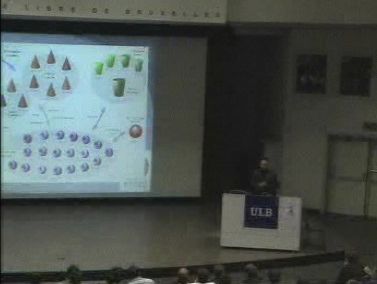
This news
message sais american congress people have messed with the wikipedia. I think that is bad,
and a bad sign about them.
A conteporary tool to achieve Freedom of Speech
Linux Fedora (core 4, 64 bit in the case of the server
this text is on) with Apache (2.something currently) web server, both
Free and Open Source software, are in use to provide more than a bit of
free information being available to the world at the moment.
15 People with 56k6 (normal) modems can connect up to the server and
simultaneously download pages or video or audio without any delay at
full speed, and the server in that case won't be more loaded than maybe
6% of its processor (nn Athlon 3.3 GHz, 64 bit) load.
Normal browsing probably takes less on average then 56k6, even when I
work with a 5 Megabit/sec connection I doubt if normal browsing ever
pulls more kilobits per second on average over the channels than that.
Pictures and of course audio/video are another story: I regularly use
300kb/s continuous alone to watch Nasa television live from the US over
the internet (hosted by yahoo). Using Yum (from RedHat Fedora
Linux) probably gets the average up far above that figure, too. Also
webcams of significant quality picture require more down- or upload
speed.
I've played with tcl CGI scripts a bit on the server, not
very professionally, just to see if I could get some things to work,
which was kind of fun. The game was this page, which
contains the output of a FPGA (Field Programmable Gate Array) which
talks to the server computer with a 100 kilobit/sec (normal) serial
link and can be programmed by the server from a Xilinx programmer file
using a paralle port cable in about 5 sec
Of course, when Verelst "plays" he is by nature not a motherf*r, but a
professional, and he's not affraid of some real issues, such as
that I wanted a webcam image of the Dilligent FPGA boards displays and
LEDs, and adapted a qc-usb package test program to give me an single
image under script control from a cheap quickcam USB webcam which was
around. This adapted testquickcam.c
has its standard output pipe one raw image to in my case cjpeg to make
it into a jpg image, like so:
testquickcam /dev/video1 -r | cjpeg > image.jpg
where the cjpeg standard linux program can be set to different
qualities and all kinds of options can be used.
I prefer to use a fixed set of capture settings, so I usually (after a
server reboot, which really isn't necessary for weeks (it certainly
runs easily for weeks with video encoding, web serving, huge file
server (10s of Gigabytes of high definition videofile copies over
100BaseT) , sometimes full time software development, remote and local
Web Browsing, and all kinds of tools including TeX, probably it can go
without system error for months) after rebooting (for for instance
recovering the USB interfaces, grr) use this program from the
qc-usb package to make the cam not autoadjust:
./qcset /dev/video1 adaptive=n
Then I regularly use camstream from the Fedore distribution (or use yum
search camstream) to view the image on a remote station (over
ethernet) and adjust the contrast and such.
This script has been tried in /var/www/cgi-bin/ with read and execute
permissions for everyone:
#!/bin/sh
# \
exec tclsh "$0" "$@"
proc exitroutine {} {
puts "</BODY>"
puts "<HTML>"
flush stdout
exit
}
puts stdout "Content-type: text/html\n"
puts stdout "<HTML>"
puts stdout "<HEAD>"
puts stdout "<TITLE>Test CGI Tcl script with FPGA communication and Webcam</TITLE>"
puts stdout "</HEAD>"
puts stdout "<BODY>"
puts stdout "Writing data to FPGA and taking webcam image first.\n<P>\n"
set t1 [clock format [clock seconds]]
exec /home/theo/Bin/testquickcam /dev/video1 -r | cjpeg > /mnt/fat/Docroot/cam/cam1.jpg
set fh [open /dev/ttyS0 RDWR]
exec /home/theo/Bin/testquickcam /dev/video1 -r | cjpeg > /mnt/fat/Docroot/cam/cam1.jpg
set fh [open /dev/ttyS0 RDWR]
fconfigure $fh -blocking 0 -mode 115200,n,8,1 -translation binary -buffering full
fileevent $fh readable {
set w [read $fh] ;
foreach c [split $w {}] {
binary scan $c H* a; set v $a
puts " $v"
# flush stdout
}
}
proc w h {
global fh
puts -nonewline $fh [binary format H* "$h"] ; flush $fh
}
puts "<P>\n"
puts "Query string: $env(QUERY_STRING)\n<P>\n"
if {[string length $env(QUERY_STRING)] == 2} {
w "$env(QUERY_STRING)0000$env(QUERY_STRING)"
} {
w 00000000
}
after 1000
set t2 [clock format [clock seconds]]
exec /home/theo/Bin/testquickcam /dev/video1 -r | cjpeg > /mnt/fat/Docroot/cam/cam2.jpg
w 40000000
puts "<img src=\"/cam/cam1.jpg\"> $t1<P>"
puts "<img src=\"/cam/cam2.jpg\"> $t2<P>"
puts "FPGA serial link return data (HEX): "
after 1000 exitroutine
while {1} {
flush $fh
vwait v
}
exit
It when this page is accessed http://www.theover.org/cgi-bin/test.tcl
shows a webcam image of the board, sends 4 bytes of binary data to the
board, takes another snapshot, and reads the return data from the
board. The point is that the script can also receive a command string
over the web page, in this case by adding a hexadecimal number to the
url, prepended by a question mark, and that number can then be seen on
the display and bit 8 of that number makes a light (a halogen spot) go
on, and then off again, as attention flash. Probably I'll add more
controllable hardware like a volume control chip, maybe a CB set, or
what else.
The Xilinx FPGA also has a Bezier subdivision unit built
in which I designed, which could be fed information and then read back
to test it, but I didn't yet connect that unit to the serial port, it
talks to a dual core 500MHz Blackfin DSP board over a 16 bits parallel
user bus at a quite much higher rate of >30MegaBytes/Sec.
That part of the FPGA is part of a active design which has also been
submitted in a paper to the SIGGRAPH conference, though of course I
don't know how that circuit will respond. I'm making a page about the
subject here, but I may not make the paper
downloadable as .tex (where it was made with) or .pdf (the submitted
format) until it has been published or rejected I guess...
Brand Names
With a guy from highschool (who incidently never finished
that education) I had a company (not a one-man business, but an
official I gues its called inc one) because I had made a database
program for (Yamaha) DX-7 sounds, which is a famous synthesizer for
which thousands of sound-programs existed, which made the instrument
when playes sound in all kinds of ways like a piano, a mallet, a bell,
a flute, etc. I also gave courses in unix (now known as Linux) , which
were even more profitable to give as a student when one could be paid
as a company, not an employee.
The company at the time was called The Source which I thought was
cool, but it didn't help to prevent my (should say 'ours' but in
fact I did ALL the programming in C) software being copied I guess...
In the SIGGRAPH paper, it's not permitted to use the TradeMark logo for
some product in the paper, I'm not even sure I could use brand names,
like Xilinx or Analog Devices. I've used product type names like Spartn
and Blackfin though.
What's with Coca Cola, Nike, Hewlett Packard, Phillips, and such, why
are those names important? For unique identification of course,
prevention of copies (like DaCosta) or stealing of the name, and I
guess in the worlds' games, the names are claimed free from all kinds
of curses and that there is honour and credibility associated with
them, like American Express, or Visa (through which I still owe my
former bank about 15kE if nothing has happened... eeks).
So theover.org would have to be like greenpeace.org or
amnesty.org . That's better then
theoverelst-consultancy.nl or theoswebshob.com .
When I was a kid, I remember the moon landings from primary school, and
I think that more than Ajax, the Olympics, Pioneer and the US Airforce,
NASA and the Apollo stickers I had made me feel and
associate something grand and supreme and desirable.
It is not permitted to just use the Nasa logo, however most of the
materials from nasa are free from copyright restrictions to use them
for any fit purpose.
AES-NL Lecture: RF-Noise
"RF Noise, Hums and Buzzes in Audio System", by Jim Brown (website see picture)
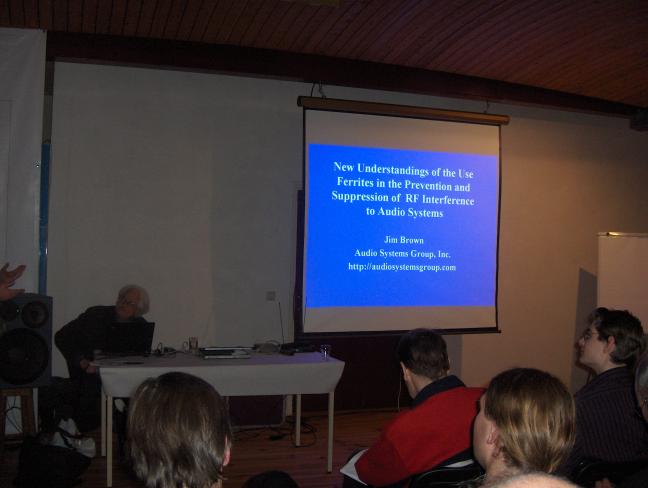
So I interfaced with one of the better american audio and high
frequency in audio experts a bit (I asked a questionduring the lecture)
and of course listened to the exposé about for instance using
ferrite torroids to filter interference from adio signal paths.
Complicated subject, probably not even known to a lot of people
somewhat in the audio field, and there were many graphs and experiment
descriptions and some theory about grounding and ground currents and
ground inductance
The computer park
Well, it aint Xerox park I'm working at, but I manage some
systems which are quite capable for consumer or even business standards
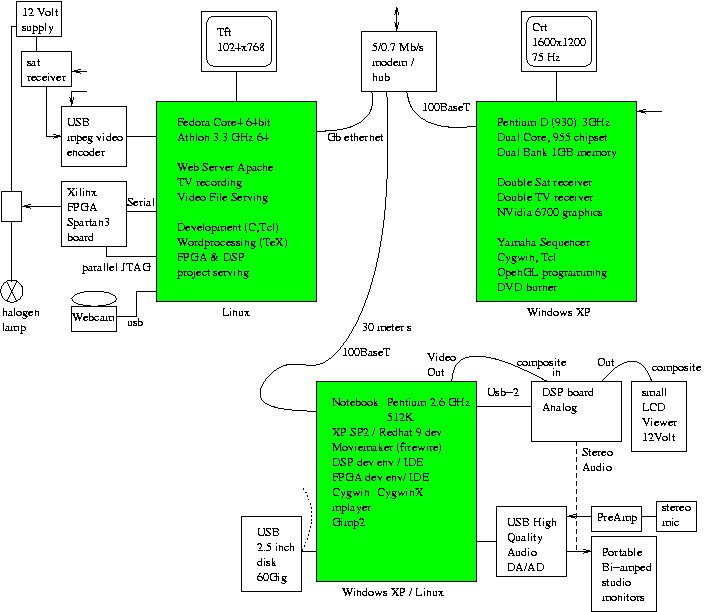
They're not mine, and only the Linux server is normally on 24/7 (with
very profi uptime figures, probably far more than 99%), everything is
completely consumer machines in terms of that they come from or are
built from normally available computer hardware, nothing special,
nothing from business companies, media markt, mycom, the supermarket,
that sort of stores, and not so much new either, nothing from space
hardware companies...
Many programs are open source, or fairly cheap like for the FPGA and
the DSP boards, nothing more than a few hundred dollars.
Modern Music: to hot to handle?
A good professor is good at asking the right questions.
When the pigs who are supposed to be more than other pigs take over,
and the corpulous black fellowmen tell us the musical gospel and the
house scene prepares our personal Brave New World, and everybody minus
a smart portion forgets we are past 1984 but not past its warning, its
hard to ask the right question, unless one appeals to the demogogs
victims and the Good Music Have-Nots.
Is there a plan behind this?
My God....
Certainly, comrades, there is a BIIIIIIIIIIIIIG plan behind this. A
good christian plan from God and the Lord Jesus, revealed to us by the
Holy Spirit and Gods Holy Apostles? No, please....
So the New Age again?
A Little Personal History
About the subject of sounds, music and the games people appearently
have played.
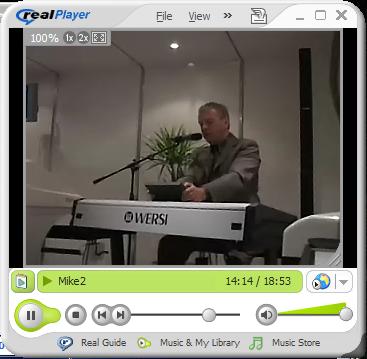
This Wersi (an electronic organ brand from Germany which
used to have build-yourself organs in the 70s) demo movie was made at
the Frankfurter Music Messe where I was physically present too, in 2005
(see my local diary page 23). At
their site I found a list of demos from last
year, realplayer movies: if you have adsl or so don't miss those kind
of things in life and have a look and listen at preferab;y your stereo
or so to organ music, unless you know it already. Very worth while.
Luckily most people nowadays will be able to afford some electronic
musical instrument like a keyboard, but of course a good organ is nice
in certain ways, and also more expensive: a top of the line wersi costs
about 40 thousand euros/dollars... And a great white finish another
8... Maybe I should offer them to design the theover/wersi organ FPGA
for the next series.
I have played at one of their organs on their stand, which even worked,
though I found it far from perfect it had some essential drawbar
possibilities and even sounded right, though I didn't push the pedal to
very high volume. I was very interested in organs when I was a
teenager, like in other instruments, too, but I had recordings and seen
live music with the Leslie enhanced machines, and knew they could make
a lot of beautiful and interesting and touching music work.
At the time (lets say '80) it was very nontrivial to make a quality
sinewave, let alone a whole bunch of them like are needed in a drawbar
organ, to produce wave for the mix-lines, lets say for 9 drawbars
(harmonic volume slider, related to the 16' (or 32 foot) 8 4, etc.
flute registers on a pipe organ which are 'drawn' by the registrator to
get more volume) every key on the keyboard lest say 49 for 4 octaves
(4x12+1) requires 49x9 sine waves. Thats a few hundred, even if you can
reuse a number of them for more than one key/harmonic, which is a LOT!.
So I made square waves making use of the for that time relatively new
digital medium scale integration chips which generated a set of notes
for a whole octave, and which I divided with signalwise well-behaved
(and new) CMOS binary dual 4 stage divider chips, which (because I
needed 6) also had the desirable property for the time (I had allowance
and stair-cleaning money, which was far from a research budget...) of
being cheap and readily available.
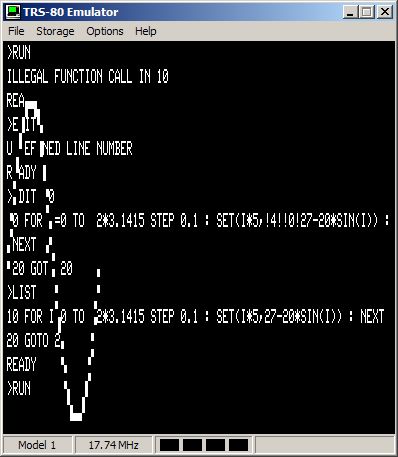
Above a little nostalgia, though honestly it wouldn't be all bad to put
this into a gameboy to do some work with at times: a trs-80 emulation
which works jusr like the old machine, it even reads its disks! The
sine wave shown is nothing compared to what I worked on when I was a
(early) teenager, and I at the time made myself hardware like AD and DA
converters for the machine which worked, and than I was only starting,
and would make all kinds of analog and digital circuits and a lot of
programs, even a sequencer, automated frequency graph measurement,
digitizers, duo-phonic digital synthesizers, a midi interface and lots
and lots more.
So in short, generating the drawbar waves must be solved
in some ingeneous way to make them high quality, like magnetical
pickups on tonewheels like in the Hammonds, or electronically with good
circuits, and requires a lot of work and parts (that's why they weren't
cheap). Nowadays, in principle one can use digital logic, and computers
to generate sine waves and good quality DA converters to make the
signals, but here's the catch: listen to any "modern" software simulation
organ or a cheap enough electronic organ or keyboard with that type of
sound and you'll find there is NO COMPARISON with a good electronic
organ from the past, of any kind, from Eminent to Hammond, not even
that good with a Farfisa (though they aren't my favorite). That's
because of the digital computations being approximations and typically not
very good ones. When I make a
sinewave simulation, I make sure they are not too bad at least, which
is not necessarily easy. Let me explain...
Tech-yes
After having in the past worked with electronics and computers
(wienbridge function generators, special purpose sine chips, all kinds
of subtractive synthesis, Trs-80 based DA conversion, and Atari ST
based DA conversion), I more recently have done varying work in the
area, first by making C programs to generate samples sine waves in .wav
(16 bit 44.1kHz CD quality mono uncompressed computer files) and a multi sample combine
prorgam (web page is time stamped 06/15/98
07:44:57 AM EDT) .
More recently I've made a program which can interactively reproduce
fairly accurate additive
synthesis samples under script (tcl) control, which makes clear
that using normal scientific programming additive synthesis table
making isn't exactly flie-sh*t for even modern computers, though it's
possible to optimize: sample tables which don't fit in the pentiums
cache (> then a few megabytes at most), which is a desirable size
when using lookups without significant interpolation (which usually
introduces inaccuracy) and when using a significant number of table
bits. I'm considering a capable FPGA engine to do additive synthsis
with good actual (uninterpolated) accuracy, and preferably real time
spectrum adjusting and limiting (to satisfy the Nyquist criterion when
changinf frequency), but thats a big subject, to which I also prefer to
bring FM synthesis so that the generators are generally usable. That's
even harder, because the bessel spectrum of a frequency modulated
signal is in theory unlimited, and also because the integral for each
sample step of the modulating operator is quite different from a the
0th or 1th order approximation, also when considering the averaged
error over a longer set of samples, which probably accounts for lousy
and dull sounding FM synthesis imitations, a good mathematical analysis
of the modulator amplitude integral which advances the phase of the
carrier FM modulators output wave is probably important.
Finally, the subject of my rejected (ahem) paper to the 2006 Paris AES
convention: the DSP which runs a analog synthesizer
emulation is based on a (currently fixed) additive synthesis made
lookup wave table of considerable size and accuracy.
I've drawn some example quantized sine waves on this tcl wiki page.
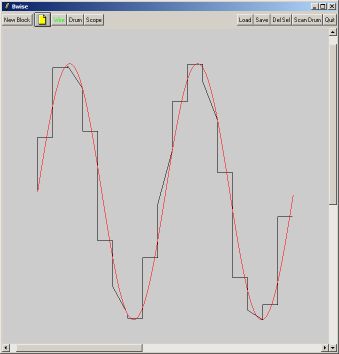
Taking all these considerations into account, the next step is the DA
converter (see small high quality
usb AD/DA converter) and the integrated reconstruction /
anti-aliasing filter, which must be of good quality, low harmonic
distortion, preferably low intermodulation distortion and clock jitter,
and decent steep but not too phase impacting reconstuction filtering,
and then the monitoring is quite non-trivial to get right: try
listening for distortion in 'clean' sine wave signals with your hifi
set or what you have: even at modest volume it is not easy to find
clean sounding products (for my monitoring apart from senheiser see big amp and medium sized powered bi-amped studio monitors).
And only then we can start to do some serious music like
from the middle ages, and appreciate playing Bach on such
music-mathematically not too invalid instrument, or it all might start
already with sounding like your and my mother together, which is at
least for one half a horrible sound.
Is high tech needed?
Well, it is of course a dream of many people to take
a PC and make the greatest music on earth, which is to an extend
possible with a good DA converter and good amplification, and of course
playing a good CD or other material.
No matter how good the PC, an mpeg recorded audio file will never sound
very good, unless very little compressed or very with limited audio
material.
Also, standard windows midi file players don't exactly sound like Bill
Gates' tax form figures.
On linux, things can be a bit different, even on a moderate sound card,
timidity, a midi player, sounds nice at least, of which I want to give
some examples, like on my previous
diary page I rendered The Shadow of
Your Smile as mpeg from a internet MIDI file.
First, an important musical comparison, which is really easy to hear.
I've taken some more midi files from the internet. Midi stands for
Musical Instrument Digital Interface, a standard way to connect sound
synthesizer equipment up since 1983 or so, which nowadays is also used
to store the notes (like in sheet music) in file form for computer use,
so that a program or synthesizer can play a piece of music with its own
tone generators which are note for note and bend for bend instructed by
the recorded Midi message stream.
Title
(length m:s)
|
Song, format
|
Bytes per second , size
|
NightBirds2.mpg (4:51)
|
Night Birds rendered with
Timidity in 24 bit stereo, mpeg compressed
|
ca 20 kByte/s, 6.5 Mega Byte
total
|
nightbirdtv.mid
(4:51)
|
The Midi file I found on the
web, with my piano addition
|
ca 86 KiloByte in total
|
nightbirdstv.mp3
(4:52)
|
The above Midi file rendered
with a S90
|
192kbps, 6.7 MB
|
The wonderfullnes achievable with an internet midi file and a modern
high quality musical synthesizer is remarkable: playing the last midi
at a party wouldn't exactly sound wrong. Playing the midi file with a
standard midi player program like windows media player is not so good.
Winamp was a bit better. Timidity a lot better: also effects are added
and the song works, is subtle , swings a bit, but still no comparison
with a professional synthesizer! Anyone try a keyboard?
Before doing these experiments oneself, I've used not all standard
settings at all: timidity was operating in 24 bit wav mode when being
fed to the lame mpeg compressor which was set at the almost highest
(and usually slow, by hey, on a 64 bit athlon at 3.3 GHz, who cares...)
quality and timidity had very high control sample rate, and high
antialias sample transposition setting. Cool.
Oh, the last midi was digitized by a standard modern sound card, not my
high quality usb AD converter.
And the piano playing is of course not exactly the way a midi would
normally be made, but fun, and good of course, but not something for a
beginners course in jazz or pop.
The registration, as in which instrument plays the varying parts of the
notes in the midi file, was completely done automatically, as were the
timidity effect settings. On the S90 I've taken a bit of time to adjust
the mix a little bit (not very much) and I had to manually make the
program changes work in the Yamaha standard sequencer, and had to set
the high byte of the drum track (channel 10) program number to
127 first.
I think its great what can be done with a synth like the
S90. Remember this is like miles and miles away from the results from a
software sound rendering program or plugin: usually nothing swings, the
mixes are hard to make work musically, the sounds are dull and dead,
and sampling artifacts abound, though often attention has been paid to
hide them a bit. Good sounds should be available, but when a song comes
together those programs don't work very musically. Timitidy (a open
source, free program) does a nice job trying to be musical, that's a
thumbs up from me. The big, major challenge, which in some cases is
met, like the synthetic strings which sound cool, is to on top of that,
make real cool and heavy and interesting and lets say standing up
sounds. The S90 is very capable of that, though if I were a test
reviewer for a magazine, I'd certainly be able to point out distinct
strengths and weaknesses, and I certainly would still appreciate the
module I used to own: a Yamaha TX802 multitibral DX7-2 rack unit: the
liveliness in the FM sounds just doesn't come from a sample or
oscillator based machine which is interesting.
Of course one could ask wether one wouldn't first have to be called
stock aitking and waterman to be thinking about all that, or wether
this isn't all a great exageration, or the proverberial f*ing of ants
which I'm very sure is not the case at all: listen to the mpegs and
your own sound rendering possibilities and make up your own mind:
that's really an easy task, a child or completely untrained music
interessee can hear the difference.
Finally: I used some very steep speaker and amplification systems (my
own build) to listen to these musical experiments. That matters. Of
course. Playing a good synth bass on a 200 Watt 4 way system with 12
inch woofers and a 15 inch sub on top of that is bound to be more in
control and deep and smooth and warm than a little milkpackage
bookshelf speaker. And a bi-amped powered monitor with extremely low
distortion pre-amplifier, electronic filter and very high quality
quadruple amplifiers is going to make wonderfull soundscapes and
transients when intructed to do so, and a transistor radio won't. All
the more in such case quality will become appearent, but also on
'normal' hifi speakers, and even multimedia speakers, the differences
should be very, very clear.
What is needed?
Good songs, and good instruments, and good musicians, and
good recording and playback equipment.
Good songs don't necessarily need lyrics, but when a song
is supposed to be good and have text, it would better be good, too. I
found this songtext when I was going over the list of top songs from
1980 I think the billboard list, let me see, well, I can't easily find
it back, but I looked up most of the top songs from that year, mostly
on amazon for a sample too, and was listening to maybe some 70s music
channel on the internet, and came across these lyrics:
IN A BROKEN DREAM
(David
Bentley)
Drinkin' wine, feelin' fine
Waitin'
here to find the sign
That I
can understand
Yes I am.
In the
days between the hours
Ivory
towers, bloody flowers
Push
their heads in to the air
I don't
care if I ever know
There I go
Don't
push your love too far
Your
wounds won't leave a scar
Right now
is where you are
In a
broken dream
Did
someone bow their head ?
Did
someone break the bread ?
Good
people are in bed
Before
nine o'clock.
On the
pad before my eyes
Paper
cries, tellin' lies
The
promises you gave
From the
grave of a broken heart
Hmm
Every day
I spend my time
Drinkin'
wine, feelin' fine
Waitin'
here to find the sign
That I
can understand
Yes I am.
Oh.
I sit
here in my lonely room
Don't
push your love too far
You know
your wounds won't even leave a scar
Right now
is where you are
In a
broken dream
And don't
you forget what I say
Hoo, hoo
Blowing in the Wind wasn't written by a certain singer who
become known by it, and this song too was done by that singer, but that
doesn't make the text less good.
A lot of Jazz music isn't vocal, but can be very good, most of what I
played as jazz musician was without vocals, though certainly not all. I
came across the '88
greatest songs' of an internet radio station of which I've played
(and liked) myself at least these:
So What
Take Five
Stolen Moments
Freddie Freeloader
Round Midnight
My Funny Valentine
Blue Bossa
A Night in Tunisia
April in Paris
Watermelon Man
Moanin'
Almost all I played in some sort of band or organised session or jam
constellation, too.
I saw this "modern" hammond organ demonstration
on the web (here):
that's good stuff, ask your local teacher to do that!

What's new ?
Well, uhm, good fusion music, that is jazz-rock, funky jazz, "new"
jazz, which is more or less a style of its own lets say from Miles over
the Brecker brothers via Yellowjackets and Stern to David Sanborn, and
of course the various other possibilities in those genres, and the
'hard core' of it... Scofield, even Santana, Weather Report, though
that's currenly only Zawinul with world stuff I guess.
That's pretty much the only really freely developing music if you ask
me, and most interesting though a bit sad.
I found "like we never loved at all" on the recent charts, thats a good
song, sung by a good artist (Faith Hill)
it appears, could be cynical, I think it's not exactly.
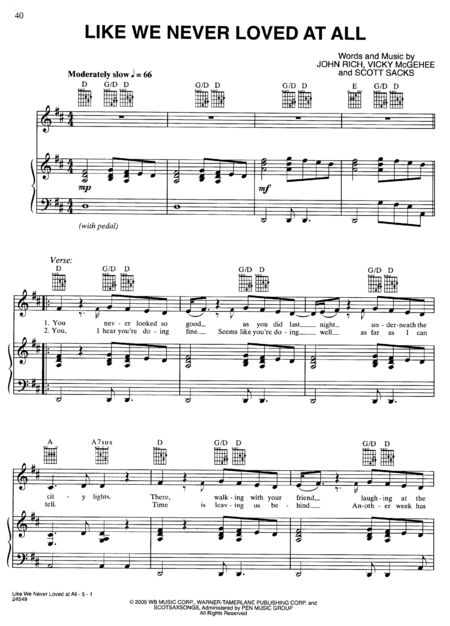
I found this examlpe here,
maybe nice to play on your organ? I'll make a version of this song
myself I think.
On another side of things, "Jesus, take the wheel", which I guess is
like a wish from the Idols tree of 'music', in the case Cary
Underwood. My god. Well, you can always turn real fascist and
invite the crazy frog to rule your life in person.
It might be that the Beatles were at first considered to wear their
hair too long (which of course for any manly or self respecting citizen
of the world is ridiculous to make a point of), Elvis might have been a
low-life fit fornight clubs because he swung his hips, and I'm sure
being
a fan of the Rolling Stones could cost you a right-wing carreer move or
two and get you labeled as undisireably non-conformist and possibly
severly unconservative, ehm sorry, unchristian, but never that
the Who was a bunch of fascists or Iggi Pop member of a neo Nazi club
or Iron Maiden secretly selling themselves to the Devil in occult
rites, or Kiss was a bunch of dreadfull pedofiles.
Or that Chicago and the Eagles where state undermining subversive
people, known to
the FBI for uncivil behaviour. Or so. Gimme a break. Or that the
Commodores were a bunch of big-mouthed niggers who should be tought a
lesson. Or somethin'.
James Brown did time. Yeah, I heard. But not for being a pusher I
recon. Some of the excellent soul musicians had to do with killings.
They were killed.
Jimmi went to vietnam. To win of the bad guys, I might hope...
Luckily one of the new things is that Jeff Wayne appears to have made a
super audio version of War of the Worlds.
I just saw Earth Wind and Fire person(s ?) in a LA session on AOL
session, which is great idea, and certainly 500kbps is fine to get an
impression of something recorded in video, and even makes with my high
Q USB DA-converter and medium sized studio monitors for more than
bearable audio to listen to without really feeling bad or in only
limitations. But why on EARTH are some of those rather weird 'new'
'musicians' on this jam? To make it better? Most certainly not, very
very certainly not. And in that context what's the point of a Candy
Dulfer-like sounding start jam? I also just saw hours of Rolling Stones
(!) life on the Copacobana Beach in Brasil, THAT too is something else,
and those old songs sound better than most anything except the real
competition.
And the music on the God channel, of our wonderfully by me influenced
"christians" ? HHHHHHIiiii HHHHAAAAhhhh (verelst rolling
under the table with laughter).
Video from the USA
Of course that's not new for me, I have said I at
times watch Nasa TV all the time, and of course many movies and such,
but I've made a little challenge this time: good quality video which
comes either from the internet or from satellite and then over a
computer network or coming from a wireless video link, goes into a DSP
card video digitizer input, get passed through a 4 frame memory, gets
converted to analog (composite colour) and is fed into a small LCD
screen at 12 volts supply.
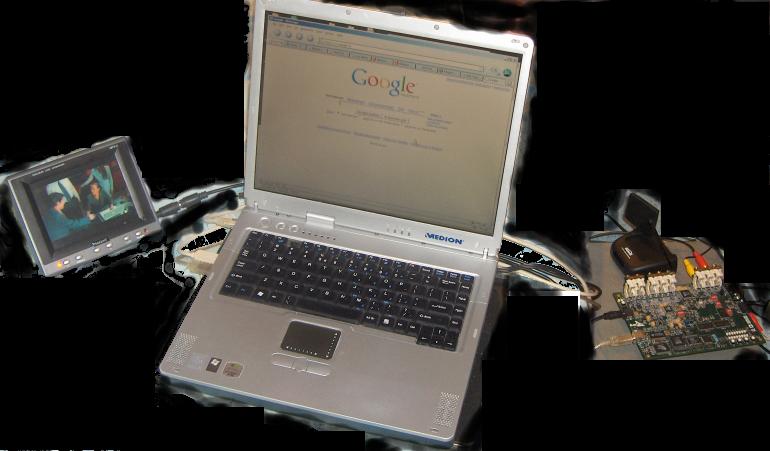
The notebook (not exactly new or unused) has a video out, which is set
ot a secondary XP screen, where the output of some video player is put,
first, this is image from a video signal tranported over a wireless
link directly out on the small screen on the left:
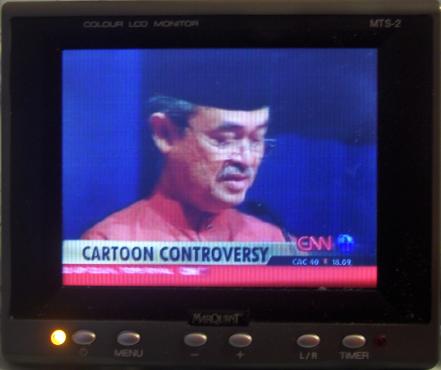
On the (fairly cheap, consumer product) LCD screen, the image is
sharper for normal perception, the text on the bottom can be read, the
cam needed too long exposure...
Now CNN which was hardware compressed and digitized at a remote PC
connected over 100BaseT ethernet is shown on mplayer running on cygwin,
which has been put on the secondary screen (running at 800x600
reolution to the video out) at fairly high quality (D1 at 5Mb/s mpeg2):
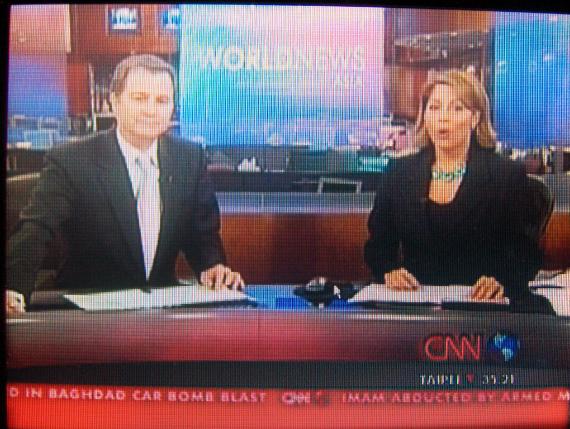
Again perceived quality is better than this phote from the little
screen, especially the patterns are absent, they come from the camera.
There is no slowness or jerkynes or artifacts in the image, it looks
solid and good, it requires considerable processing power, of course.
Now lets look at Nasa TV!
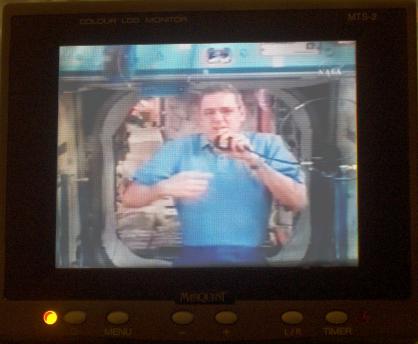
Our converted Jesuit commander (can I say that ?) in action explaining
about weightlessness effects, probably with thoughtfull proximity of Mr
Valery the russion engineer somewhere on the space ship. This signal
also on the picture looks a little less good, and of course a good and
large notebook screen is nicer, though this screen is fairly bright,
but still its nice to look at the little flatscreen, and the image is
definately good and most of the time without any noticable artifacts,
except the 300kb/s progressive coding (when luckily active at the
server) isn't perfectly sharp all the time, that's impossible.
Also the ISS downlink is far from perfect, though of course it's
an interesting signal path: Space Station camera --> to earth
downlink --> Nasa encoder --> Internet connection --> Cross
ocean internet link --> Local internet provider router machines
--> Consumer internet modem --> Long ethernet cable -->
Notebook video player --> Analog output --> DSP card with
AD->DA --> SCREEN !
The actual quality of the little screen, still connected over a
composite output from a PC which still is first fed through a DSP board,
can be seen with the easier to digitally photograph still image:
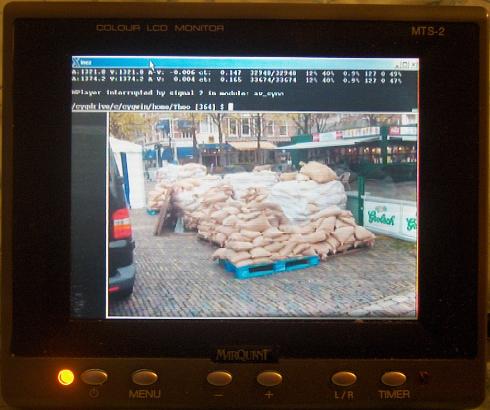
The text is half readable, I should adjust the font to a bit bigger,
but the cygwin X window doesn't refresh on the second screen.... Most
application work OK though, like windows picture viewer showing an
picture I made in the Hague when preperations were being made for the
recording of a movie about 2d world war.
The fun of the DSP to begin with is, and I haven't proceeded beyond
that point, that the image capture core of the dual core DSP chip can
be stopped, or better put the DMA channel associated with video capture
can be disabled:
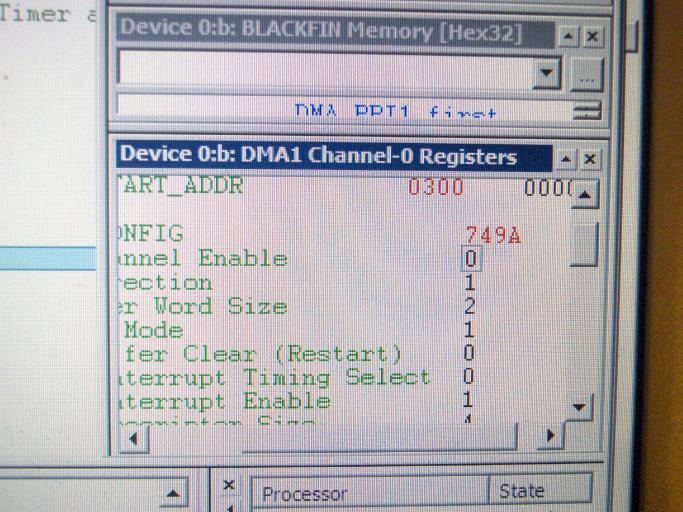
For people knowledgeable about The VisualDSP++ Blackfin Integrated
Development Environment, I've opened a window on DMA unit 1
channel 0, where I've disabled that channel by fillin in a 0 instead of
a 1. The resulting image is a repeated loop of 4 half- images, or 2
full frames, which looks like this little mpeg
movie (about 700kB).
Of course one of the purposes, apart from a low power extra screen,
saving the notebook screen, is to give a machine like a synthesizer
which I made with a similar DSP board a fashionable color screen to
display parameters on, and this way it's easy to record and test images
I could use for a user interface. I've made only a line drawing driver
once for that purpose which using the single core DSP was very slow
when starting from the example sources.
Prince of Orange Custom Synth Show business plan
Well, that's an idea only.
But ideas are important, like why's a Ford Mustang a nicer
car than a Renault Clio? Well maybe it isn't true, cars aren't persons,
and it is clear there are reasons for products to score high in a
consumer test. But suppose we take a Lambourgini and a Tessa Rossa car,
bot comparable weight, speed, motor power, like in Formula-1, but very
different. Now suppose you win a million dollar and can buy either,
what is then the better car?
Hard to say.
Maybe the faith of the inventor, the color, the second
hand prices, which rock star bought them, etc.
That game is quite hard to describe, though every sane grownup man will
have at least opinions about such subject by the dozen, and be very
sure about what they think and probably will even be able to utter
sensible things about the subject.
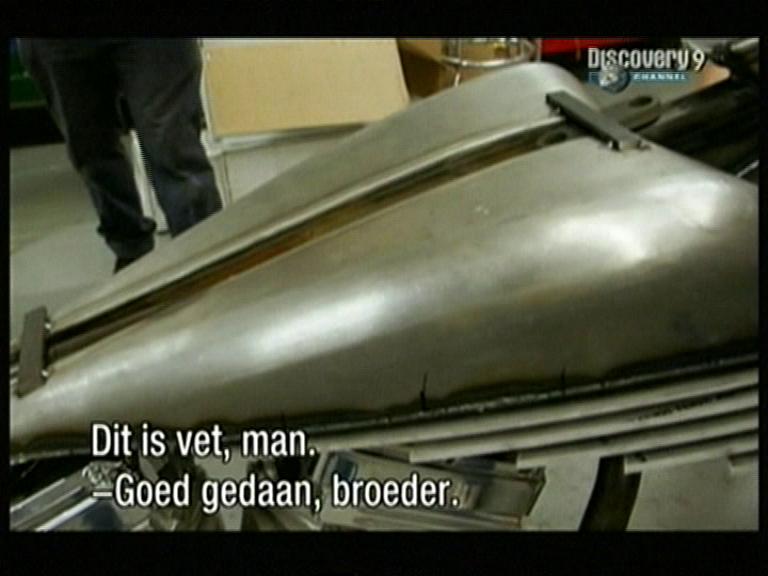
How long would the car in Back to the Future look fast? Forever?
Shown are some screen dumps from the American Shopper TV show, let me
be clear: I think the owner runs the show, somehow, and I think the
"thing" the bike, of this episode (I'm sure fans would know) also can
be spoken about in many ways.
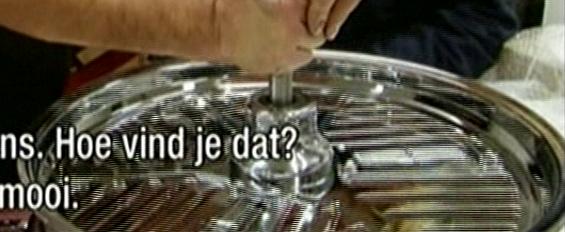
I remember seeing on Discovery channel and on the Internet about the
biggest tanks, and the jet-engine Abraham tank, for instance used in
the (1st) gulf war: why would those dreadfull german machines look like
they look and why is that important: what a battletank looks like?
Lets take 3 example car doodles on the proverbial napkin 1, 2 and 3:
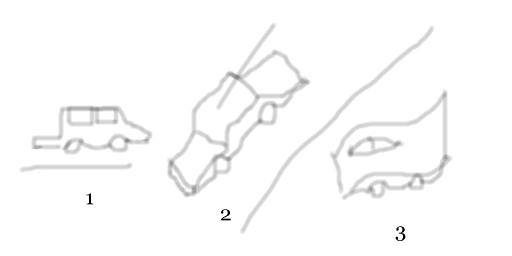
and do a little non-sesame street associations in terms of coolness,
usefullness, datedness maybe. The first car (1) is a T ford like model,
or resembling model later on: everything straight, like a chariot. The
second (2) is a nice and smooth, spacey, luxury lets say Opel Omega
GHIA, though it could be for the purpose a BMW 512i or so (which I
really don't fancy that
much), number (3) is supposed to be a scetch of one of those large
race-type cars with smooth and low air resistance body with spoiler big
engine, small cockpit, special tires, etc.
Now the following setup, where A are big studio/PA monitors (with heavy

Also, one can wonder what HiFI companies do to make their product
flyers with pictures which look smooth and glossy.
One could also think about the animal food chain as in what is the
highest, Analog Devices has done that with their DSP series, which are
all shark names. In that context I think I favour having or making the
Orca, which is the killer whale. I found that that is the highest
predator in the seas, which eats
sharks, like Jaws was about, it ways up to 10 tons, being up to 10
meters long, and swims up to 50 kilometers per hour through the oceans
of the world. It is a mammal (warm blooded) and has never been known to
attack a human being, except isolated incidents have occured with
animals in captivity. Oh and let the piranahs not get smart ideas in
their little heads: we could send them sweet water dolphins to eat them
(!), and as I said, orcas appear to even eat sharks.
Soedah
That's indonesian, I guess all variations behassa,
whatever. I've been near some dutch 'indo' s who came to holland after
second world war, which is not exactly a thrilling experience, so I
picked up some of the vibes when I ate there where that was and
listened to some people. I think I'm quite not indonesian by nature,
though I guess it's a beautifull country, unfortunatly with more than a
few moslims in it, but then again general Babylon is also very evil, as
most will have picked up reading or knowing about me, I'm probably more
american inclined than all other people, and the indonesian way is
probably quite far from mine, though if their hierarchy is absent
(which I gues it often isn't) and the subjects are neutral, they're
aimable and nice people, which certainly isn't bad. Also, it is a great
country, unlike the poststamp Holland, which isn't necessarily bad
either.
Those poor indonesians, which of course have quite a place in dutch
history, because the dutch colonolized them long and let them become
independent in the stream of such events fairly recenty, were robbed of
many of their riches, and of course also suffered in second world war,
during the japanese occupation of their tropical land, are in holland
seen as the potential underdog, which is popular a view amoung many
dutch oriented people, as in someone who is a bit pathetic can easily
afford to try to be accepted as popular.
Moluk people in holland try to be handy in that context in a rather low
way. In indonesia, dutch is also today still being tought in schools
I'd think correct me if I'm wrong, there are more indo-dutch speakers
then holland dutch, I guess. When I was a kid I guess I didn't find
indonesian people very interesting a contrast with 'normal' white boys
and girls, I guess too much a part of dutch normal life, but I wasn't
aware of the great tension apart form colonialism which existed after
the second world war and the dutch army having still battled in that
country, if I know correctly even simply to continuate dutch
imperialism which has made liberation from the japanese (they luckily
surrendered completely after the (small but devastating) nuclear bombs
on the cities of Hiroshima and Nagasaki costing over half a million
lives) together with the already difficult subject of colonisation and
exploitation and being 'alies' in that war a great tension field, where
people easily get more than irritated and upset, also in public for
instance concerning the KNIL. Which wasn't exactly like dutchbat in
yugoslavia, but many indonesian freedom fighters feel betrayed by the
dutch.
The people I knew were from indonesia itself, so grew up
there, so they had a childhood which was in a much much bigger country
than holland, which I guess has advantages. The word which I used to
name this section of my local diary page 31 with describes a way in
which indo people deal with important issues, though I wouldn't say
it's a summary of their nature, it's just a significant part of their
thinking I think.
I knew the meaning of the expression of course, but I though it was fun
to look it up on the internet, but it appears that the international
dictionary set doesn't contain a indonesian section, and somehow the
dutch dictionary didn't seem to contain the word. Searching a bit I
came across a page with a speech from a for me well known non-profit
organisation called Pelita. They are an intermediate between the dutch
state and war victims, which helps those victims apply for war-trauma
related social security in a special form from the dutch gouvenrment.
They have a number of people who interview indonesian people who
suffered from the war and make a report which is used by the social
department to determine which people can count on a social services
income.
I 'had' 2 friends who worked there, and it always struck me as a bit
marginal and vague though relevant. Reading the speech I found here
I though it was rather devastating what the easy fascist interpretation
could simply be: make your way to the top with some story and forget
about the actual wrongs and causes of the fight. From the general
description of the mission
of the organisation:
Voor alle drie de
wetten geldt, dat, wil men in aanmerking komen voor
een uitkering, men ziekten of gebreken moet hebben overgehouden aan
gebeurtenissen in de oorlog of Bersiapperiode. Deze ziekten en gebreken
moeten in het latere leven van de aanvrager/ster hebben geleid tot
inkomensderving. Dat wil zeggen, dat de hoogte van de uitkering,
verleend in het kader van een van de hier beschreven wetten, wordt
bepaald door het verschil tussen het werkelijke inkomen en het inkomen,
dat men zou hebben gehad bij een volledige gezondheid.
In (fast translated) english:
"For all three laws it holds that to be
elligeble for a social check, one must have deseases or shortcomings
because of the events in the war or the Bersiap time period. These
deseases and shortcomings must later in life of the requester have led
to loss off income. That is: the amount of welfare, granted in the
context of the laws here described, is determined by the difference
between the actual income, and the income. which one would have had
when completely healthy."
Well, apart from passive against active language forms, and possibly
some inaccuracies, the tendency is simple: this organisation which is
probably the main one helps people ask for money from the dutch
gouvernment when they can show they have been permanently hurt by the
war ingoings of certain kinds.
So maybe I should claim I'm in a war! And then in the country
which is famous for the lowness of compensation assignments maybe ask
to be compensated for trying to fight the child and women abusers and
certain important wronggoings in top universities or such. Appealing to
general mercy and goodnes isn't going to do much. And of course there
is the disadvantage of seeing myself as a victim as long as I associate
more with an army then anything else that is usually a sign of weakness
in the social struggle, even though I remember people with jobs in the
sector in any laguage deny that of course.
Well, anything you want done in holland is likely to get smuthered and
let get stuck in the mud of quasi-cosy-talk, as is illustrated by the
case of the indonesian monument as described on the site.
It is rather distastefull how certain lines of thought and utterances
can easily be taken reading all that stuff. Sort of like fascism rules,
and nobody even cares, and I doubt weather most people even can see the
difference. Brrrr. What a life.
Anyhow, the last line of the speech contains the word "soedah", which
is translated as "laat maar" in english something like "let it be" or
better "just forget about it", "leave it", "fine if that's ok with
you", "let's not make more of this" "forgiven, don't mention it".
Forget it. Not going to happen. Wrong line. Wrong way to deal with the
dutch, I should know: my family had enough of a nazi in them to know
what to do to rule all that, if they'd have the power. You NEVER say
'ok that's it' until you got the other person down, until the logic is
exhausted and "heil hilter" could be said properly. And never show
weakness or mercy when you don't really have to, and you never just
give things away unless that's in the family tree. Ugh.
"But they are nicer people!" So, them let them give nice things to us,
except well, uhm, Indonesia has a lot of oppression behind it, like the
slave black people for instance, is a big country with nice weather and
a lot of natural resource richness a looooong tradition of hierarchical
thinking and it probably isn't impressed with holland much. It might
NOT say "soedah"...
Warrantees at theover.com ?
Well, to be clear upfront: there is no theover.com!!!
There is a theover.org but no
dotcom.
If somebody feels called or wants to be decent or nice or thinks its a
good idea to create a theover.com, fine, good idea, I guess I need:
some product engineers who listen and dont mess about, some people to
make production tick, some sales people including a law knowledgeable
person and book keeper, various representatants, preferably abroad and
in the US, also traveling product manager/salesman/women, some nice
secretaries (ha ha), some good company properties for the
directorate/R&D lab preferably
the sunny but not too hot parts of california (nodge nodge), maybe a
doorman, and stock and transport humans, and a good set of hardware and
software makers of various levels, and maybe production people, though
I wouldn'n know what's handy in that department, depending on what I'd
do.
So? Well, that's been done before, but theoverelst the californian
millionaire hasn't, har har. And of course some research kinds are
important, and musical equipment is fun, and its a better starting
point for various jobs: director general of amnesty international or
greenpeace, president of the AES for great achievements in the
democratisation of high quality audio after the Crime of the Century
was being commited, though I'm not sure I like having my good paper
after unnice circumstances rejected, and well, taking speaking turns
anywhere from the pulpit to the board of directors or the poet society
is probably easier then.
And buying a great HD or even better film camera and making a great
auditorium for it is a lot easier then, too. Or forgetting about ever
having to have lived in holland except for some exceptions, too. And
telling world intelligence services some good stories about dutch
fascism/terrorist games and the inner workings of the whore of Rome her
deep science games, including her jesuit dogs in the american
university world. Pheew.
So suppose I'd make speakers, amplifiers, DA/DA converters, computer
programs, Sound Synthesizers, and other products, possibly on a small
order basis, maybe like that the director of Phillips wants a real
special piece of audio equipment which I then make in my synth shop, or
a professor from some dutch university wants a special practicum design
for top digital design classes, but then not like something that
doesn't even win from the past microprocessor praticum but a system
which is good to train top engineers with to understand the technology
for decades to come.
Well, I guess such a order would be cool, and if the money is good a one man business or
whatever organisational form is a manner of hiring a bookkeeper for a
few days. And a good name can be made such a way, and the comparison
with the bike shop is that people might like such products, and its an
area of life which has been heavily under enemy fire since the
beginnings of the new age and the rule of the hidden masters or
whatever crap bulsh*t crap you want to call it.
Maybe I should be an army general first. What would be the required
education and experience for that? 10 years sarge, 5 years office, 5
years combat experience, air force degree in electronics? Nah.
I guess I'll be a new-rock star. I can do that. Though maybe the 70s
music was already getting more advanced!
More HD TV
This picture is from a real hogh definition tv program, an example. It
is actually TWICE as big in each direction! Great!

The next (from Paris) is also from HD1 high def 1080 television
receivable (not y me) by satellite and a HD receiver, unfortunately
there is a need for a smartcard to decode the stream, otherwise I could
try to get the signal working.

This image is made from an actual unprocessed
screendump of a video stream recorded from satellite, from BBC.

On a CRT (not a TFT lets say) this looks real good, in this case
because I used TrueVideo (from NVidia) decoding which on the (rather
heavy) graphics card does a lot of compensation and interpolation in
real time in various video/image domains (I think) to make motion and
perceived sharpness and image pleasantness very nice. The grainyness I
see on a TFT screen normally doesn't seem visible and motion looks
natural an unstraining and quite unrestrained by interpolation
limitations or speed limitations or lets say interlace or progressive
decoding artifacts, really pretty cools as it seems.
Not like the above stills, mind you, thats still a big difference, but
images like below are not seen on a 'normal' TV, so the movie theater
experience is certainly a lot nicer, like the next image, also from
purevideo running sat movie material (resolution like 2/3 of 720p, I
think):

On a fast (64 bit Athlon) machine running Linux, I screendumped this
from mplayer:
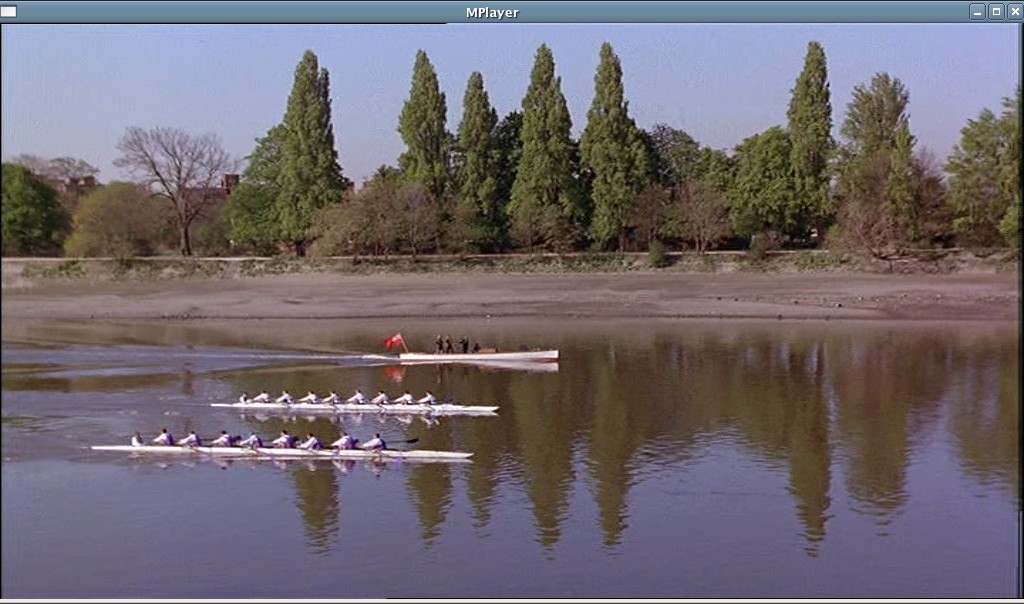
Also nice, but not as good. Motion is smooth, but I have the strong
impression that depending on the coding (and maybe reception (error
correcting?)) conditions and problems, motion compensation and such
don't make it up to the hardware PureVideo sultion. Lots of processing
power and bandwidth reserver though: 2 or 3 of the above simultaneous
on the same machine don't overload it!
Making Contemporary Consumer Computer Graphics
Well, that's a big subject, even for a top university, and without
including computer architecture and electronics.
Computer graphics started when computers started, but became seriously
usable a little later, and that's long ago already! In the 70s, already
serious machines, programs, papers and artwork were available, but
currently, the higher rated graphics cards and machines are really more
close to a new kind of supercomputer, with a lot of comptutation power
and very good image results.
There are a lot of issues with graphics and moving images and video,
like anti-aliasing. The following demo (from recent openGL demos I
think from NVidia) shows a rotating triangle with various anti-aliasing
filters (click to get a (moderate quality) mp4 video I made from the
screen):
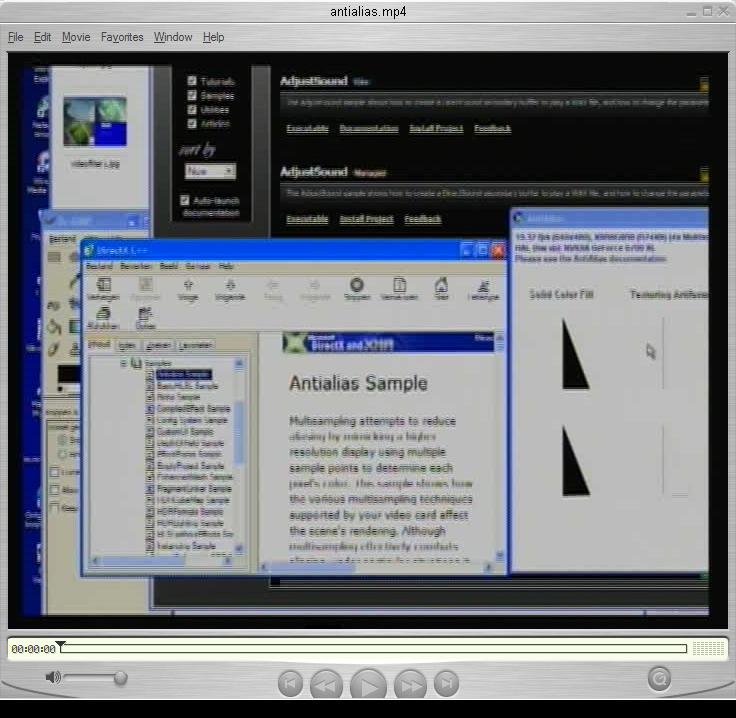
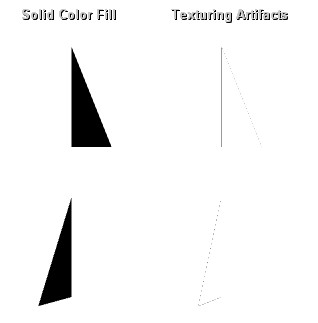
This is a more catchy demo: a chevrolet which can be looked at with
reflections and all from all angles in a simulated space (which is only
a picture, but the car is a true 3d model), great to do on 1600x1200 in
real time with good frame rate, wonderfull:
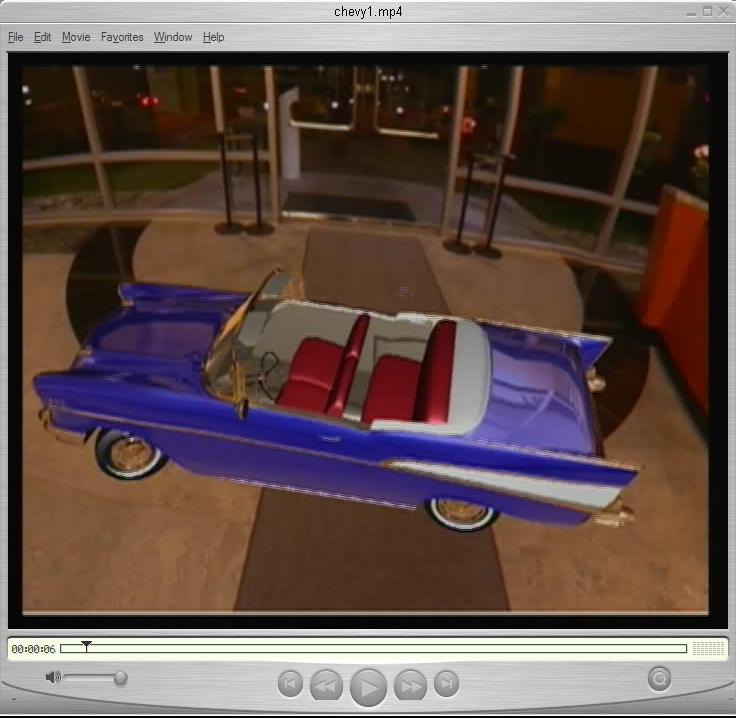
This demo shows the shader language and card possibilities of opengl
2.0 or 3.0: the statue is truely tranlucent while it is turned around
in real time and blurr effects are also real time with very good frame
rate (compeletely smooth fast motion without any jerkyness or
unclearness):
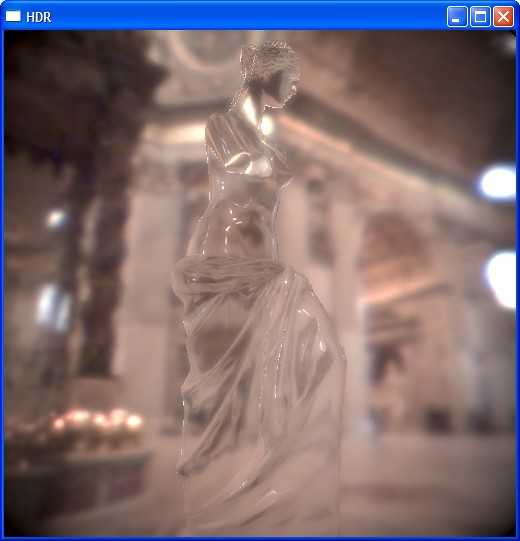
The next is another view of the above, remember the reflection change
in real time!
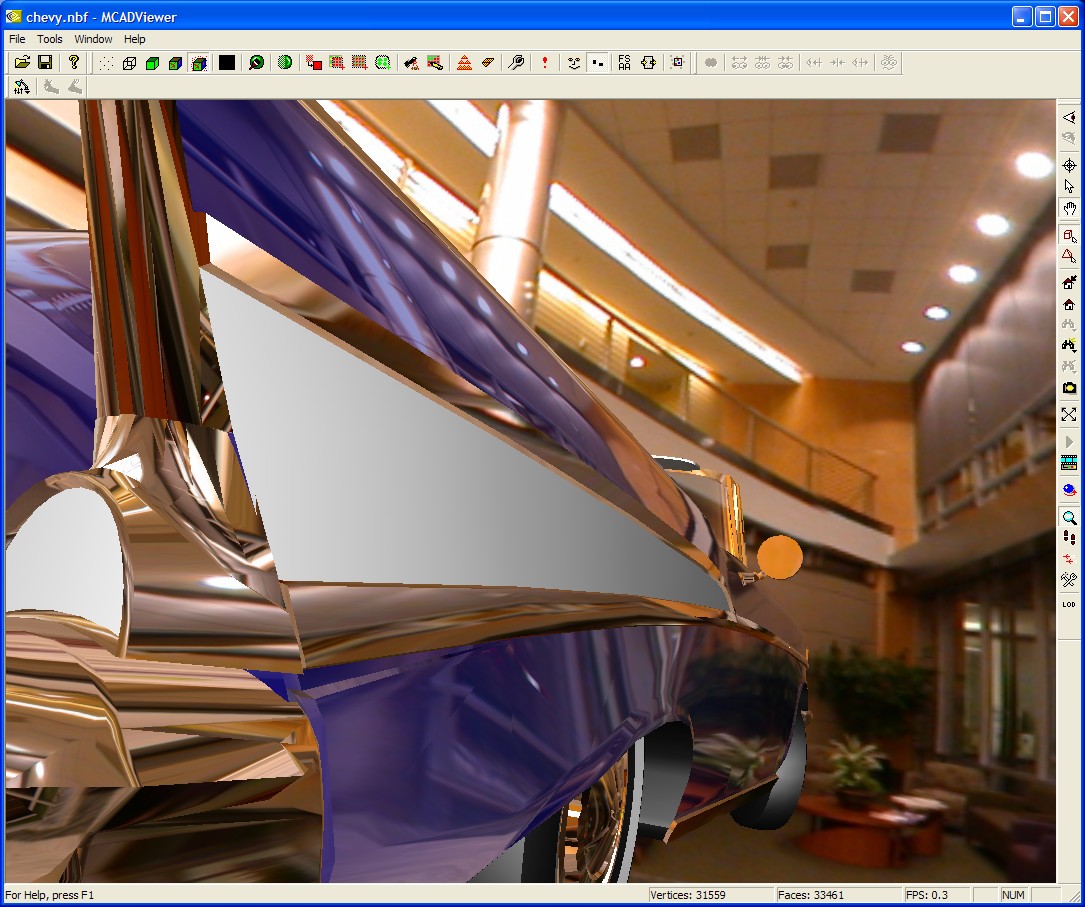
Getting a still (1 image) of this quality with POVray probably already
takes minutes, but this including the metal effects of the car comes at
a great 1600x1200 true colot resolution at 60 frames per second or so...
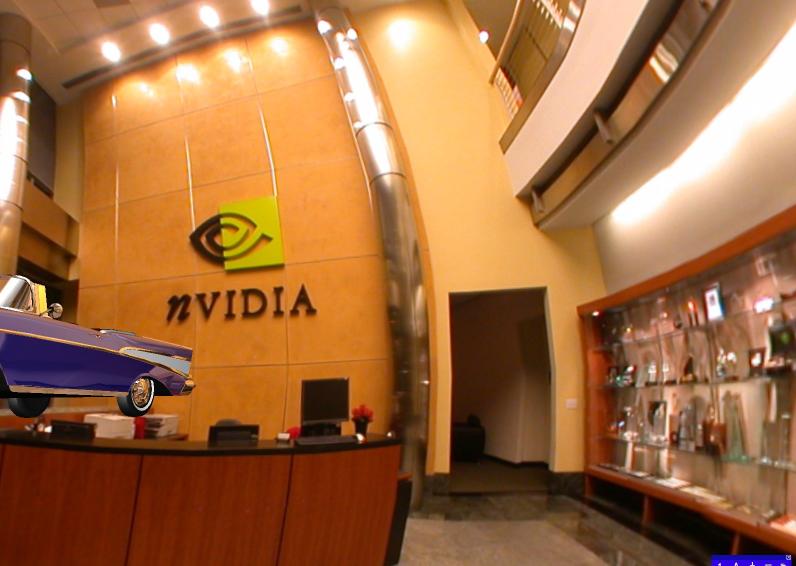
Another demo shows 2 video streams playing from file at the same time,
both getting effects, and a mix of the two video channels is shown
simultaneously at full frame rate with no jerkeyness or great CPU load:
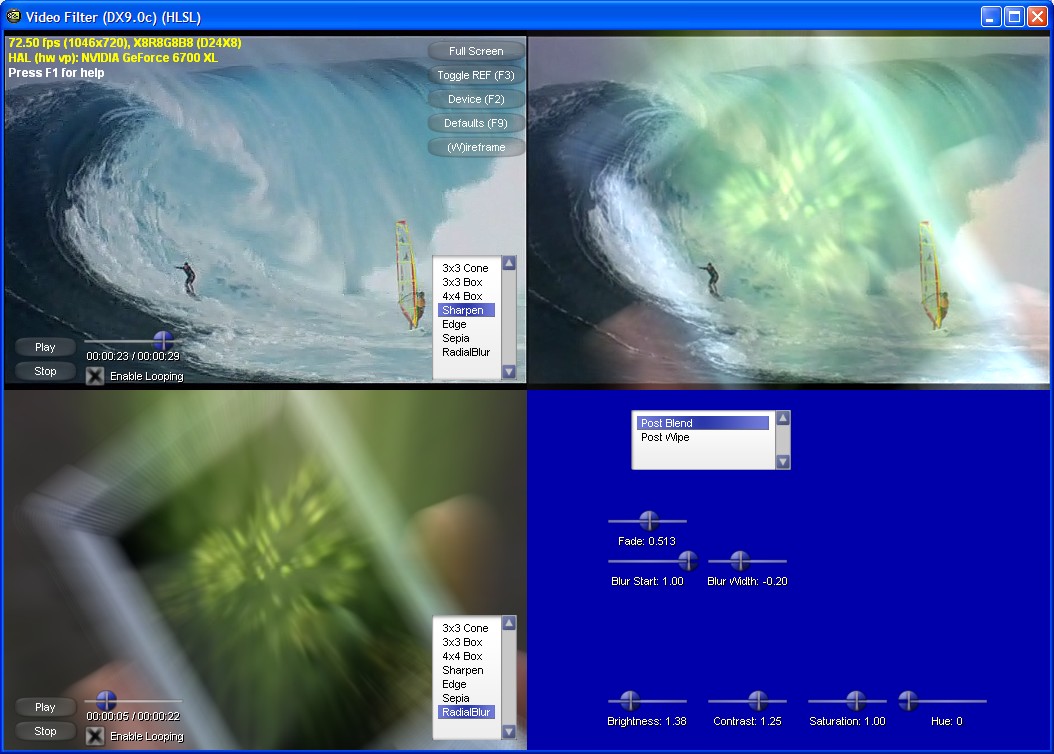
To make ones' own shader effects, NVidia has a free effects composer,
which is shown next:

I installed Visual C++ Express and the platform SDK to do some
compilation, which didn't work good, I had to hand prompt to include
files and such to get some stuff compiling, and then still things
didn't work. Well, it's not normally anticipated this is like great
stuff, but at least its free.
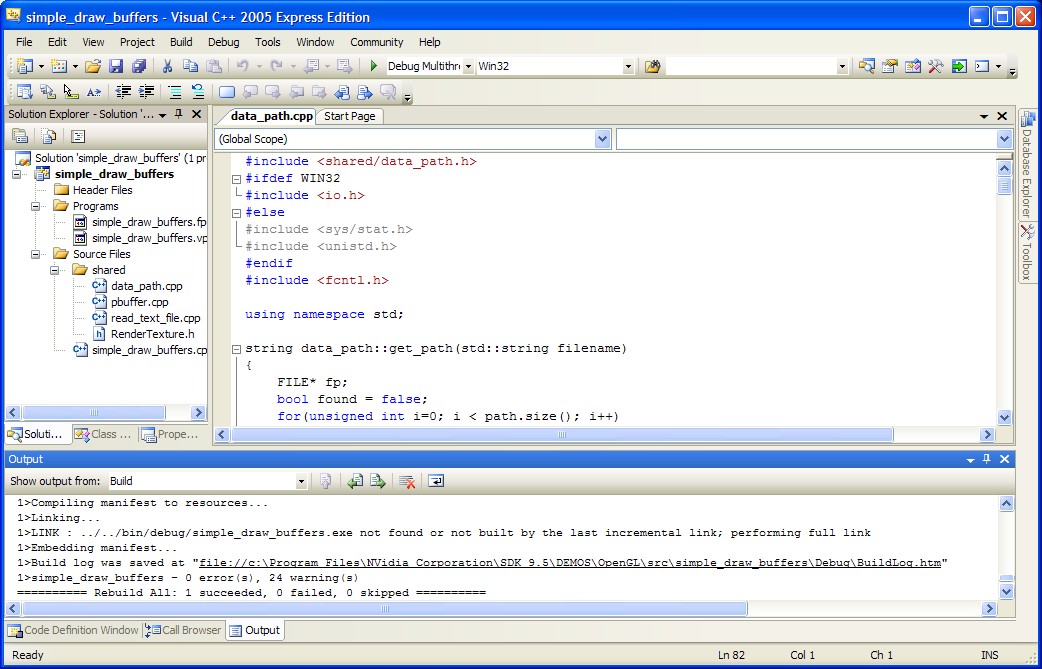
See the next diary page for a better solution ....
























